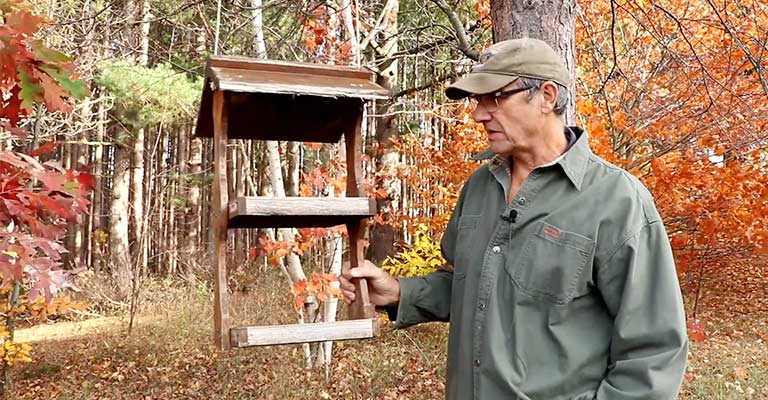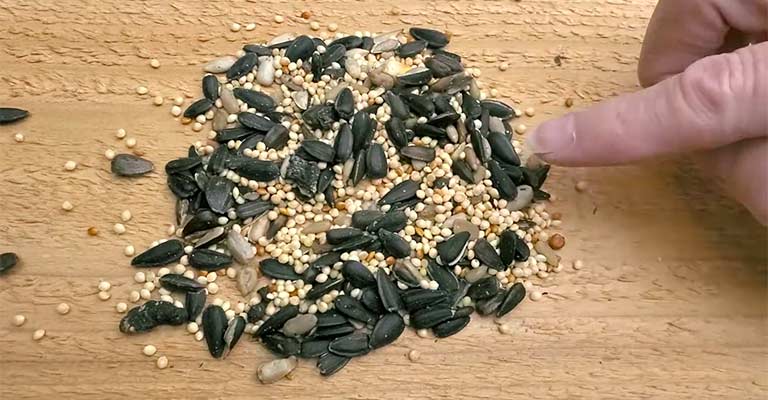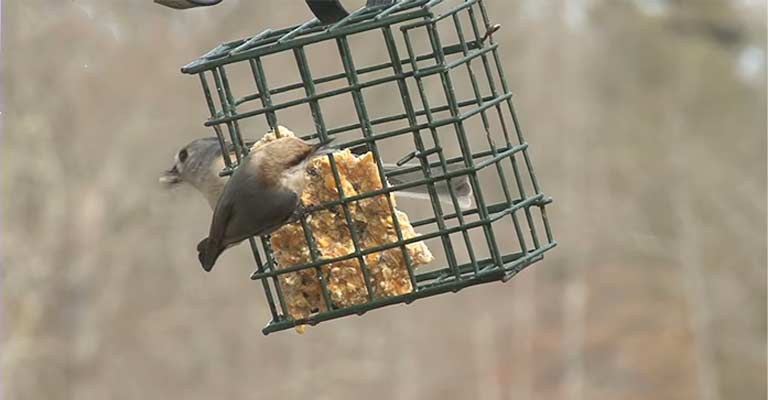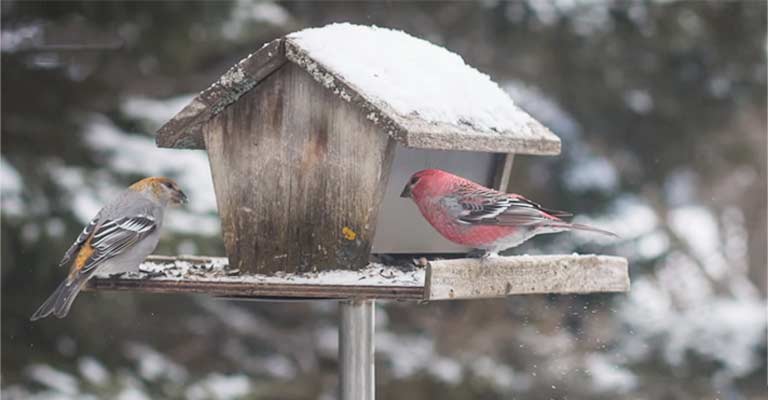Birdwatching enthusiasts often find joy in setting up bird feeders, eagerly anticipating the colorful array of feathered visitors.
However, the disappointment of watching once-active feeders become deserted raises the question: Why do birds abandon a bird feeder? Understanding the reasons behind this behavior is crucial for fostering a thriving avian haven in your backyard.
Whether it’s changes in environment, feeder placement, or the types of seeds offered, deciphering the signals that lead birds to seek alternative dining spots can enhance your bird-feeding experience.
In this exploration, we delve into the intricacies of avian behavior, shedding light on the subtle factors that influence our feathered friends’ decisions to stay or migrate to new feeding grounds.
Join us on a journey to uncover the secrets behind the fluctuations in bird activity at your feeder and discover how to create an irresistible haven for your avian companions.

Why Birds Abandon A Bird Feeder?
Bird feeders provide a delightful opportunity to observe and connect with avian visitors, but the occasional abandonment of these feeding stations can leave enthusiasts puzzled.
Understanding the reasons behind why birds abandon a bird feeder involves exploring various factors, from environmental changes to feeder maintenance and bird behavior.
Seasonal Shifts
Birds’ feeding habits often correlate with seasonal changes. In colder months, natural food sources may dwindle, making feeders more appealing. Conversely, abundant natural food during warmer seasons might draw birds away.
Predators and Disturbances
The presence of predators, such as neighborhood cats or squirrels, can deter birds from frequenting feeders. Unsettling disturbances, like loud noises or sudden movements, may also contribute to their reluctance.
Proximity to Shelter
Birds prefer feeders close to natural shelter, allowing them quick escapes from predators. If a feeder is too exposed or far from cover, birds may feel vulnerable and avoid it.
Maintaining cleanliness is crucial. Spoiled or contaminated food can harm birds, and dirty feeders may spread disease. Regular cleaning ensures a safe and inviting feeding environment.
Type of Feeder and Seed

Birds have distinct preferences for feeder types and seed varieties. Experimenting with different feeders and seed mixes can attract a diverse range of bird species.
Some bird species exhibit dominant behaviors at feeders, intimidating others and monopolizing resources. This can discourage less assertive birds from using the feeder.
Changing Social Dynamics
Bird communities are dynamic, with individuals forming hierarchies. Social changes, such as the arrival of new birds or the departure of established ones, can alter the dynamics at a feeder.
Birds are creatures of habit. Inconsistency in providing food may lead them to seek more reliable food sources elsewhere.
Unappealing Feeder Design
The design of the feeder itself can influence bird behavior. Awkward or inaccessible feeders may discourage birds from using them.
Offering a variety of seeds, fruits, and suet can attract a diverse array of bird species, ensuring a consistent presence at your feeder.
Shelter Integration
Position feeders near trees or shrubs to provide a sense of security for birds. This proximity to natural shelter encourages more frequent visits.
Routinely clean feeders, remove spoiled food, and ensure a fresh water source nearby. A well-maintained feeding station is more likely to attract and retain bird visitors.
Patience and Observation
Bird behavior is dynamic, and patience is key. Observing their habits allows you to adapt your approach and create an environment that caters to their specific needs.
In unraveling the mystery of why birds abandon a bird feeder, it becomes evident that multiple interconnected factors contribute to their decisions.
By addressing these aspects thoughtfully and adapting to the evolving needs of your feathered visitors, you can create an inviting space that fosters a thriving and harmonious relationship between birds and birdwatchers.
How to Prevent Birds from Abandoning a Feeder?

To ensure a consistent and lively avian presence, it’s essential to address various factors that influence birds’ decisions. Here’s a comprehensive guide on how to prevent birds from abandoning your feeder:
Proximity to Natural Shelter
Birds instinctively seek safety. Placing your feeder near trees or shrubs provides birds with quick escape routes from predators, making them feel secure while dining.
Avoid crowding multiple feeders in a small space. Adequate spacing minimizes territorial disputes among birds and creates a more inviting environment.
Sheltered from Harsh Elements
Position feeders in areas sheltered from strong winds and extreme weather conditions. Birds are more likely to frequent feeders that offer a comfortable dining experience.
Different bird species have unique dietary preferences. Offering a diverse selection of seeds, such as sunflower seeds, millet, and nyjer seeds, caters to a broader range of birds.
Fruits and Suet
Expand the menu by adding fruits and sweets. Fruits like apples and berries attract species that enjoy a fruity treat, while suet provides essential fats, especially beneficial during colder months.
Regularly replenish the feeder with fresh, high-quality seeds. Spoiled or contaminated food can drive birds away, as they instinctively avoid potential health risks.
Feeder Design and Accessibility
Experiment with different feeder styles. Tube feeders, platform feeders, and suet cages appeal to various bird species. Observing which designs attract more visitors can guide your choice.
Ensure that feeders are accessible to birds of all sizes. Adjustable perches or trays accommodate different species, preventing larger birds from monopolizing the feeder.
Easy to Clean
Opt for feeders that are easy to disassemble and clean. Regular cleaning prevents the buildup of mold and bacteria, maintaining a hygienic feeding environment.
Consistent Feeding Schedule

Birds thrive on routine. Establish a consistent feeding schedule, ensuring that the feeder is reliably stocked. This reliability encourages birds to incorporate the feeder into their daily foraging routine.
Year-Round Provision
Maintain a year-round feeding schedule. While winter may attract more birds seeking supplemental food, consistent feeding throughout the year establishes your space as a dependable food source.
Minimize Disturbances
Implement strategies to deter predators, such as installing baffles or placing feeders in predator-resistant locations. Birds are more likely to frequent feeders where they feel safe from potential threats.
Reduce Human Disturbances
Minimize human disturbances around the feeder area. Birds may be sensitive to loud noises or sudden movements, so maintaining a quiet and calm environment encourages their regular visits.
Foster a Harmonious Social Environment
If possible, set up multiple feeding stations. This minimizes competition among birds and allows them to establish individual feeding territories.
Observe the social dynamics among birds. Some species are more dominant, while others may be more submissive. Understanding these dynamics helps in creating an environment where all birds feel welcome.
Water Source
Provide a freshwater source near the feeder. Birds require water not only for drinking but also for bathing. A convenient water source enhances the overall appeal of your bird-friendly space.
Bird behavior is dynamic and can be influenced by various factors. Patience and keen observation allow you to adapt your approach, ensuring that your feeder remains an enticing destination for your feathered friends.
Make Adjustments as Needed
If you notice a decline in bird activity, be open to making adjustments. Whether it’s changing the type of seed, repositioning the feeder, or addressing environmental changes, flexibility ensures the ongoing success of your bird-feeding endeavor.
Preventing birds from abandoning a feeder requires a thoughtful and multifaceted approach. By considering factors such as feeder placement, food variety, design, and maintaining a bird-friendly environment, you can create an irresistible haven for birds.
As you follow these steps and consider the needs of both birds and birdwatchers, you can create an inviting and safe space for avian visitors.
Hanging a bird feeder is not just a practical task; it’s an investment in fostering a thriving ecosystem and enjoying the beauty of nature right in your backyard.
FAQs
Why Are Birds Abandoning My Bird Feeder?
Birds may abandon feeders due to various reasons. Common factors include changes in seasons, the presence of predators, unappealing feeder design, or the lack of a diverse and fresh food supply.
Addressing these issues, such as adjusting feeder placement or offering a variety of seeds, can help retain bird interest.
What Types of Seeds Are Most Attractive to Birds?
Different bird species have distinct dietary preferences. However, universally popular seeds include sunflower seeds, nyjer seeds, and millet. Experimenting with a mix of these seeds in your feeder can attract a diverse range of birds, ensuring a lively and dynamic birdwatching experience.
How Can I Deter Predators from the Bird Feeder Area?
To discourage predators like cats or squirrels, consider installing baffles on poles or placing feeders in locations that are harder for predators to access. Creating a safe and secure feeding environment will help birds feel more comfortable and reduce the risk of abandonment.
Should I Feed Birds Year-Round, or Only During Certain Seasons?
While birds are more reliant on supplemental feeding during harsh seasons like winter, maintaining a year-round feeding schedule is beneficial.
This consistency establishes your space as a reliable food source, encouraging birds to visit regularly and potentially reducing the likelihood of feeder abandonment.
How Often Should I Clean My Bird Feeder?
Regular cleaning is crucial for maintaining a healthy and inviting feeding environment. Clean your bird feeder at least once every two weeks, or more frequently if needed.
Remove any spoiled or contaminated food, scrub the feeder, and ensure it’s thoroughly dried before refilling. Cleanliness prevents the spread of disease and encourages birds to frequent your feeder.
Conclusion
The ebb and flow of bird activity at your feeder is a nuanced interplay of various factors, weaving a delicate tapestry of nature’s rhythms in your backyard.
Beyond the mesmerizing spectacle of feathered visitors, understanding the intricacies of this avian ballet reveals a fascinating world where environmental shifts, feeder maintenance, and culinary offerings play pivotal roles.
Changes in the environment act as a silent orchestrator, influencing the comings and goings of different bird species. Seasons bring forth not only alterations in temperature but also shifts in food availability, prompting fluctuations in the avian crowd.
Migratory patterns, breeding seasons, and local weather conditions all contribute to the dynamic ballet of wings in your outdoor space.
A well-maintained feeder becomes a reliable stage, encouraging a diverse array of bird species to grace your outdoor sanctuary. Conversely, neglecting this task may disrupt the delicate equilibrium, deterring birds and hindering the flourishing avian community.
Meta: